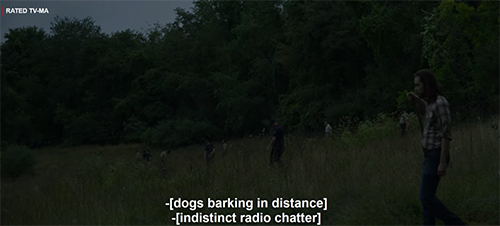Cross-post (4)
By:
October 31, 2019
I keep the subtitles on at night. I do this to keep the house quiet, and I do this because, often as not, I’m watching some British show in which everything sounds to my American ears like an erudite mumble. In the case of Mindhunter, the Netflix serial-killer show now enjoying a second season, it’s the former. Everything stated in these East Coast accented voices is distinct and clear to my (natively) East Coast hearing — and the Southern voices, too, perhaps because the Southern accents are being spoken generally by people who want their utterances to be heard (whether they are beleaguered law enforcement, concerned bystanders, or vain convicts).
Late at night, the captions keep the living room’s televised noises from traveling too far around the house, and as a result I get glimpses at the way the hearing-impaired captioning is framing the on-screen action, the encapsulation of the sonic mise-en-scène.
This particular shot (from midway through season 2, episode 6) is a rare instance of dual caption cues. It’s far more the norm for a single sound — “footsteps,” “eerie music,” “fan rattling” — to be selected set the tone for a given moment, but here two distinct elements (“dogs barking in the distance,” “indistinct radio chatter”) combine to achieve the desired effect, the desired summary of effects, the desired way to read the scene. On TV, it’s generally the case that more than one sound is at work at a given time: score plus multiple bits of diegetic ambience, as well as dialog. (Jason Hill’s score to Mindhunter is the show’s main nod to contemporary aesthetics: all warped slivers of sound, synthesized haze, and other such meticulously designed treats.) In the moments when dialog is absent, such as here, the background sounds edge toward the foreground.
As watchers of mysteries, we, the audience, are the dogs in this picture, sniffing out (or, in this case, keeping an eye out for) clues. When two sonic cues appear, our eyes and ears are alerted simultaneously to the seriousness of the moment.
This is of course a David Fincher production, which is to say a hyper-detailed one in which the most mundane physical objects — a period vehicle, an abandoned warehouse, a small forest — is likely to be the result of hours of CGI transformation. At a moment like this, it’s not hard to imagine Fincher himself, the model of a Hollywood perfectionist, having made the call: “No, neither the dogs nor the radio alone is sufficient. We need both.”
Marc’s original post on Disquiet: I Keep the Subtitles On at Night
The Disquiet blog: https://disquiet.com/
Marc on Twitter: @disquiet

